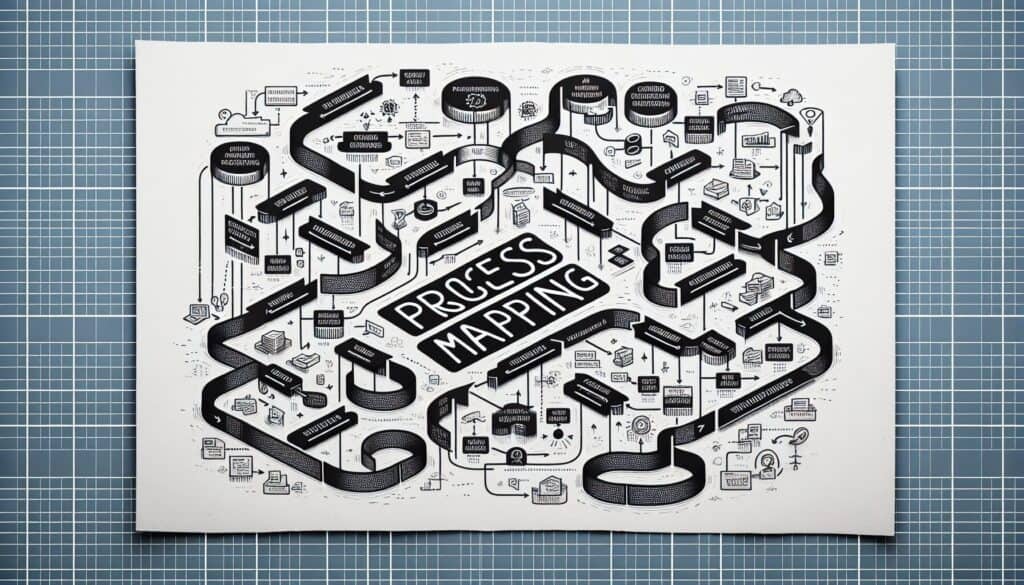To visually represent the sequence of activities, decisions, and information flow within a process to understand its current state and identify areas for improvement.
- المنهجيات: العملاء والتسويق, الاقتصاد, لين سيجما, تصنيع, إدارة المشاريع, الجودة
تخطيط العمليات

تخطيط العمليات
- إعادة هندسة عمليات الأعمال (BPR), التحسين المستمر, التصنيع اللين, تحسين العمليات, تخطيط العمليات, تحسين العمليات, إدارة المشاريع, إدارة الجودة, تخطيط مسار القيمة
الهدف:
كيفية استخدامه:
- Involves identifying all steps in a process, who performs them, and how they connect, then creating a diagram (e.g., flowchart, swimlane diagram) using standardized symbols.
الايجابيات
- Provides a clear visual understanding of complex processes; Helps identify bottlenecks, redundancies, and inefficiencies; Facilitates communication and collaboration among stakeholders; Forms a baseline for process improvement.
سلبيات
- Can be time-consuming for complex processes; Static representation may not capture dynamic process variations; Requires active participation from process owners and stakeholders for accuracy.
الفئات:
- لين سيجما, تصنيع, حل المشكلات, إدارة المشاريع, الجودة
الأفضل لـ
- Understanding existing workflows, identifying improvement opportunities, standardizing processes, and training.
Process mapping is widely utilized across various sectors, including manufacturing, healthcare, finance, and software development. In manufacturing, it can be employed during the design phase of production systems, enabling teams to visualize the entire manufacturing workflow from raw material procurement to final product delivery, helping to identify potential inefficiencies and areas for automation. In healthcare, process mapping is often initiated by quality assurance teams to visualize patient care paths, thus improving patient outcomes and ensuring compliance with regulatory standards. In the finance sector, process maps are useful for documenting compliance procedures and internal controls, ensuring that all team members understand their roles and responsibilities in maintaining regulatory standards. During project management phases, cross-functional teams collaborate to create these diagrams, ensuring that all stakeholders have a shared understanding of workflows. Training initiatives also benefit significantly, as onboarding new employees with visual aids aids retention and provides clarity, reducing training time. Various tools can be employed for creating diagrams, including software like Microsoft Visio, Lucidchart, or specialized process mapping tools that enhance collaboration and allow for continuous updates as processes evolve. The visualization of workflows through process mapping empowers teams to continuously refine operations, supports إدارة التغيير initiatives, and enhances overall organizational efficacy.
الخطوات الرئيسية لهذه المنهجية
- Identify the process boundaries, defining the start and end points of the process.
- List all steps involved in the process in sequential order.
- Assign roles and responsibilities to individuals or teams for each step.
- Outline connections and interactions between steps to display dependencies.
- Select appropriate standardized symbols and notation for the diagram.
- Create a visual representation of the process using the chosen diagram type.
- Validate the process map with stakeholders for accuracy and completeness.
- Identify areas of redundancy, bottlenecks, or inefficiencies within the map.
- Document any recommended changes and improvements based on findings.
- Update and maintain the process map regularly to reflect ongoing changes.
نصائح للمحترفين
- Involve cross-functional teams during the mapping sessions to ensure diverse perspectives and a comprehensive understanding of workflows.
- Regularly review and update process maps to reflect changes in practices, technologies, or organizational structure, maintaining relevance and accuracy.
- Leverage process mapping software for advanced features like version control, collaboration tools, and integration with other project management systems to enhance usability.
لقراءة عدة منهجيات ومقارنتها, نوصي باستخدام
> مستودع المنهجيات الشامل <
مع أكثر من 400 منهجية أخرى.
نرحب بتعليقاتكم على هذه المنهجية أو المعلومات الإضافية على قسم التعليقات أدناه ↓، وكذلك أي أفكار أو روابط متعلقة بالهندسة.
السياق التاريخي
1949
1950
1950
1960
1960
1960
1960
1940
1950
1950
1958
1960
1960
1960
1960
(إذا كان التاريخ غير معروف أو غير ذي صلة، على سبيل المثال "ميكانيكا الموائع"، يتم تقديم تقدير تقريبي لظهوره الملحوظ)















منشورات ذات صلة
استبيانات الانزعاج العضلي الهيكلي
الاختبار متعدد المتغيرات (MVT)
تحليل الانحدار المتعدد
أنظمة التقاط الحركة
طريقة MoSCoW
اختبار متوسط المزاج